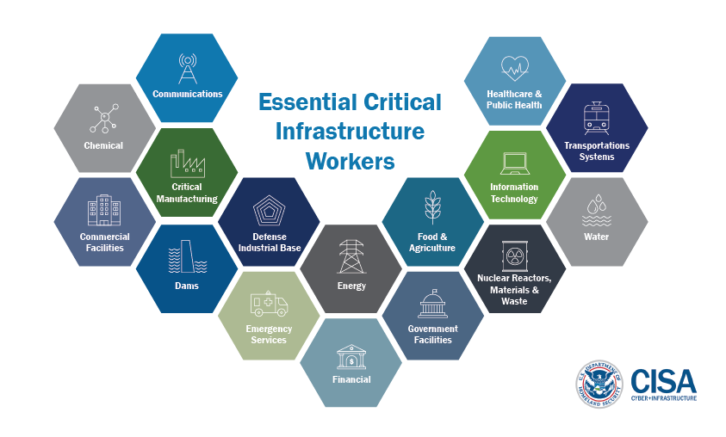 The AV industry serves many of the nation’s sectors that are considered Essential Infrastructure. Most of these sectors will need to remain operational and will also need to enhance their infrastructure with capabilities such as remote collaboration and services, surveillance, and security among others, In locked down states, professionals who are needed to “maintain continuity of operation of the federal critical infrastructure sectors can continue to go to site or offices as needed.
The AV industry serves many of the nation’s sectors that are considered Essential Infrastructure. Most of these sectors will need to remain operational and will also need to enhance their infrastructure with capabilities such as remote collaboration and services, surveillance, and security among others, In locked down states, professionals who are needed to “maintain continuity of operation of the federal critical infrastructure sectors can continue to go to site or offices as needed.
There are 16 critical infrastructure sectors whose assets, systems, and networks, whether physical or virtual, are considered so vital to the United States that their incapacitation or destruction would have a debilitating effect on security, national economic security, national public health or safety, or any combination thereof. Presidential Policy Directive 21 (PPD-21): Critical Infrastructure Security and Resilience advances a national policy to strengthen and maintain secure, functioning, and resilient critical infrastructure. This directive supersedesHomeland Security Presidential Directive 7.
The section on Guidance on the Essential Critical Infrastructure Workforce helps to clarify guidelines for the continued operation of critical infrastructure during the COVD-19 pandemic.Here are the categories and definitions of critical infrastructure according to US Department of Homeland Security.
Chemical Sector
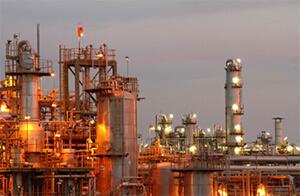 The Department of Homeland Security is designated as the Sector Sector-Specific Agency for the Chemical Sector. The Chemical Sector is an integral component of the U.S. economy that manufactures, stores, uses, and transports potentially dangerous chemicals. The Chemical Sector—composed of several hundred thousand U.S. chemical facilities in a complex, global supply chain—converts various raw materials into more than 70,000 diverse products that are essential to modern life. Based on the end product produced, the sector can be divided into five main segments, each of which has distinct characteristics, growth dynamics, markets, new developments, and issues:
The Department of Homeland Security is designated as the Sector Sector-Specific Agency for the Chemical Sector. The Chemical Sector is an integral component of the U.S. economy that manufactures, stores, uses, and transports potentially dangerous chemicals. The Chemical Sector—composed of several hundred thousand U.S. chemical facilities in a complex, global supply chain—converts various raw materials into more than 70,000 diverse products that are essential to modern life. Based on the end product produced, the sector can be divided into five main segments, each of which has distinct characteristics, growth dynamics, markets, new developments, and issues:
- Basic chemicals
- Specialty chemicals
- Agricultural chemicals
- Pharmaceuticals
- Consumer products
Commercial Facilities Sector
 The Commercial Facilities Sector includes a diverse range of sites that draw large crowds of people for shopping, business, entertainment, or lodging. Facilities within the sector operate on the principle of open public access, meaning that the general public can move freely without the deterrent of highly visible security barriers. The majority of these facilities are privately owned and operated, with minimal interaction with the federal government and other regulatory entities.
The Commercial Facilities Sector includes a diverse range of sites that draw large crowds of people for shopping, business, entertainment, or lodging. Facilities within the sector operate on the principle of open public access, meaning that the general public can move freely without the deterrent of highly visible security barriers. The majority of these facilities are privately owned and operated, with minimal interaction with the federal government and other regulatory entities.
The Commercial Facilities Sector consists of eight subsectors:
- Entertainment and Media (e.g., motion picture studios, broadcast media).
- Gaming (e.g., casinos).
- Lodging (e.g., hotels, motels, conference centers).
- Outdoor Events (e.g., theme and amusement parks, fairs, campgrounds, parades).
- Public Assembly (e.g., arenas, stadiums, aquariums, zoos, museums, convention centers).
- Real Estate (e.g., office and apartment buildings, condominiums, mixed use facilities, self-storage).
- Retail (e.g., retail centers and districts, shopping malls).
- Sports Leagues (e.g., professional sports leagues and federations).
 The private sector, as owners and operators of the majority of communications infrastructure, is the primary entity responsible for protecting sector infrastructure and assets. Working with the federal government, the private sector is able to predict, anticipate, and respond to sector outages and understand how they might affect the ability of the national leadership to communicate during times of crisis, impact the operations of other sectors, and affect response and recovery efforts. Over the last 25 years, the sector has evolved from predominantly a provider of voice services into a diverse, competitive, and interconnected industry using terrestrial, satellite, and wireless transmission systems. The transmission of these services has become interconnected; satellite, wireless, and wireline providers depend on each other to carry and terminate their traffic and companies routinely share facilities and technology to ensure interoperability.
The private sector, as owners and operators of the majority of communications infrastructure, is the primary entity responsible for protecting sector infrastructure and assets. Working with the federal government, the private sector is able to predict, anticipate, and respond to sector outages and understand how they might affect the ability of the national leadership to communicate during times of crisis, impact the operations of other sectors, and affect response and recovery efforts. Over the last 25 years, the sector has evolved from predominantly a provider of voice services into a diverse, competitive, and interconnected industry using terrestrial, satellite, and wireless transmission systems. The transmission of these services has become interconnected; satellite, wireless, and wireline providers depend on each other to carry and terminate their traffic and companies routinely share facilities and technology to ensure interoperability.
Critical Manufacturing Sector
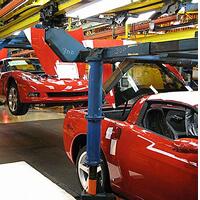 The Critical Manufacturing Sector identified several industries to serve as the core of the sector:
The Critical Manufacturing Sector identified several industries to serve as the core of the sector:
- Primary Metals Manufacturing
- Iron and Steel Mills and Ferro Alloy Manufacturing
- Alumina and Aluminum Production and Processing
- Nonferrous Metal Production and Processing
- Machinery Manufacturing
- Engine and Turbine Manufacturing
- Power Transmission Equipment Manufacturing
- Earth Moving, Mining, Agricultural, and Construction Equipment Manufacturing
- Electrical Equipment, Appliance, and Component Manufacturing
- Electric Motor Manufacturing
- Transformer Manufacturing
- Generator Manufacturing
- Transportation Equipment Manufacturing
- Vehicles and Commercial Ships Manufacturing
- Aerospace Products and Parts Manufacturing
- Locomotives, Railroad and Transit Cars, and Rail Track Equipment Manufacturing
Dams Sector
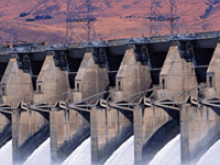 The Dams Sector delivers critical water retention and control services in the United States, including hydroelectric power generation, municipal and industrial water supplies, agricultural irrigation, sediment and flood control, river navigation for inland bulk shipping, industrial waste management, and recreation. Its key services support multiple critical infrastructure sectors and industries. Dams Sector assets irrigate at least 10 percent of U.S. cropland, help protect more than 43 percent of the U.S. population from flooding, and generate about 60 percent of electricity in the Pacific Northwest. There are more than 90,000 dams in the United States—approximately 65 percent are privately owned and approximately 80 percent are regulated by state dams safety offices.
The Dams Sector delivers critical water retention and control services in the United States, including hydroelectric power generation, municipal and industrial water supplies, agricultural irrigation, sediment and flood control, river navigation for inland bulk shipping, industrial waste management, and recreation. Its key services support multiple critical infrastructure sectors and industries. Dams Sector assets irrigate at least 10 percent of U.S. cropland, help protect more than 43 percent of the U.S. population from flooding, and generate about 60 percent of electricity in the Pacific Northwest. There are more than 90,000 dams in the United States—approximately 65 percent are privately owned and approximately 80 percent are regulated by state dams safety offices.
Defense Industrial Base Sector
 The Defense Industrial Base Sector is the worldwide industrial complex that enables research and development, as well as design, production, delivery, and maintenance of military weapons systems, subsystems, and components or parts, to meet U.S. military requirements. The Defense Industrial Base partnership consists of Department of Defense components, more than 100,000 Defense Industrial Base companies and their subcontractors who perform under contract to the Department of Defense, companies providing incidental materials and services to the Department of Defense, and government-owned/contractor-operated and government-owned/government-operated facilities. Defense Industrial Base companies include domestic and foreign entities, with production assets located in many countries. The sector provides products and services that are essential to mobilize, deploy, and sustain military operations. The Defense Industrial Base Sector does not include the commercial infrastructure of providers of services such as power, communications, transportation, or utilities that the Department of Defense uses to meet military operational requirements. These commercial infrastructure assets are addressed by other Sector-Specific Agencies.
The Defense Industrial Base Sector is the worldwide industrial complex that enables research and development, as well as design, production, delivery, and maintenance of military weapons systems, subsystems, and components or parts, to meet U.S. military requirements. The Defense Industrial Base partnership consists of Department of Defense components, more than 100,000 Defense Industrial Base companies and their subcontractors who perform under contract to the Department of Defense, companies providing incidental materials and services to the Department of Defense, and government-owned/contractor-operated and government-owned/government-operated facilities. Defense Industrial Base companies include domestic and foreign entities, with production assets located in many countries. The sector provides products and services that are essential to mobilize, deploy, and sustain military operations. The Defense Industrial Base Sector does not include the commercial infrastructure of providers of services such as power, communications, transportation, or utilities that the Department of Defense uses to meet military operational requirements. These commercial infrastructure assets are addressed by other Sector-Specific Agencies.
Emergency Services Sector
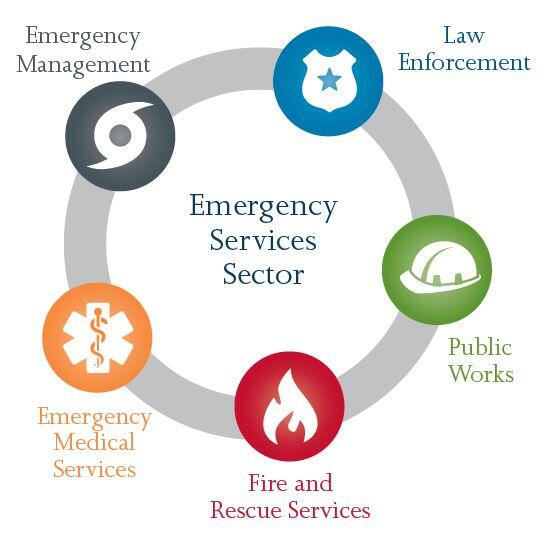 The Emergency Services Sector (ESS) is a community of millions of highly-skilled, trained personnel, along with the physical and cyber resources, that provide a wide range of prevention, preparedness, response, and recovery services during both day-to-day operations and incident response. The ESS includes geographically distributed facilities and equipment in both paid and volunteer capacities organized primarily at the federal, state, local, tribal, and territorial levels of government, such as city police departments and fire stations, county sheriff’s offices, Department of Defense police and fire departments, and town public works departments. The ESS also includes private sector resources, such as industrial fire departments, private security organizations, and private emergency medical services providers.
The Emergency Services Sector (ESS) is a community of millions of highly-skilled, trained personnel, along with the physical and cyber resources, that provide a wide range of prevention, preparedness, response, and recovery services during both day-to-day operations and incident response. The ESS includes geographically distributed facilities and equipment in both paid and volunteer capacities organized primarily at the federal, state, local, tribal, and territorial levels of government, such as city police departments and fire stations, county sheriff’s offices, Department of Defense police and fire departments, and town public works departments. The ESS also includes private sector resources, such as industrial fire departments, private security organizations, and private emergency medical services providers.
Five distinct disciplines compose the ESS, encompassing a wide range of emergency response functions and roles:
- Law Enforcement
- Fire and Rescue Services
- Emergency Medical Services
- Emergency Management
- Public Works
The ESS also provides specialized emergency services through individual personnel and teams. These specialized capabilities may be found in one or more various disciplines, depending on the jurisdiction:
- Tactical Teams (i.e., SWAT)
- Hazardous Devices Team/Public Safety Bomb Disposal
- Public Safety Dive Teams/Maritime Units
- Canine Units
- Aviation Units (i.e., police and medevac helicopters)
- Hazardous Materials (i.e., HAZMAT)
- Search and Rescue Teams
- Public Safety Answering Points (i.e., 9-1-1 call centers)
- Fusion Centers
- Private Security Guard Forces
- National Guard Civil Support
Energy Sector
 The energy infrastructure is divided into three interrelated segments: electricity, oil, and natural gas. The U.S. electricity segment contains more than 6,413 power plants (this includes 3,273 traditional electric utilities and 1,738 nonutility power producers) with approximately 1,075 gigawatts of installed generation. Approximately 48 percent of electricity is produced by combusting coal (primarily transported by rail), 20 percent in nuclear power plants, and 22 percent by combusting natural gas. The remaining generation is provided by hydroelectric plants (6 percent), oil (1 percent), and renewable sources (solar, wind, and geothermal) (3 percent). The heavy reliance on pipelines to distribute products across the nation highlights the interdependencies between the Energy and Transportation Systems Sector.
The energy infrastructure is divided into three interrelated segments: electricity, oil, and natural gas. The U.S. electricity segment contains more than 6,413 power plants (this includes 3,273 traditional electric utilities and 1,738 nonutility power producers) with approximately 1,075 gigawatts of installed generation. Approximately 48 percent of electricity is produced by combusting coal (primarily transported by rail), 20 percent in nuclear power plants, and 22 percent by combusting natural gas. The remaining generation is provided by hydroelectric plants (6 percent), oil (1 percent), and renewable sources (solar, wind, and geothermal) (3 percent). The heavy reliance on pipelines to distribute products across the nation highlights the interdependencies between the Energy and Transportation Systems Sector.
Financial Services Sector
 The Financial Services Sector includes thousands of depository institutions, providers of investment products, insurance companies, other credit and financing organizations, and the providers of the critical financial utilities and services that support these functions. Financial institutions vary widely in size and presence, ranging from some of the world’s largest global companies with thousands of employees and many billions of dollars in assets, to community banks and credit unions with a small number of employees serving individual communities. Whether an individual savings account, financial derivatives, credit extended to a large organization, or investments made to a foreign country, these products allow customers to:
The Financial Services Sector includes thousands of depository institutions, providers of investment products, insurance companies, other credit and financing organizations, and the providers of the critical financial utilities and services that support these functions. Financial institutions vary widely in size and presence, ranging from some of the world’s largest global companies with thousands of employees and many billions of dollars in assets, to community banks and credit unions with a small number of employees serving individual communities. Whether an individual savings account, financial derivatives, credit extended to a large organization, or investments made to a foreign country, these products allow customers to:
- Deposit funds and make payments to other parties
- Provide credit and liquidity to customers
- Invest funds for both long and short periods
- Transfer financial risks between customers
Food and Agricultural Sector
 The Food and Agriculture Sector is almost entirely under private ownership and is composed of an estimated 2.1 million farms, 935,000 restaurants, and more than 200,000 registered food manufacturing, processing, and storage facilities. This sector accounts for roughly one-fifth of the nation’s economic activity.
The Food and Agriculture Sector is almost entirely under private ownership and is composed of an estimated 2.1 million farms, 935,000 restaurants, and more than 200,000 registered food manufacturing, processing, and storage facilities. This sector accounts for roughly one-fifth of the nation’s economic activity.
Government Facilities Sector
 The Government Facilities Sector includes a wide variety of buildings, located in the United States and overseas, that are owned or leased by federal, state, local, and tribal governments. Many government facilities are open to the public for business activities, commercial transactions, or recreational activities while others that are not open to the public contain highly sensitive information, materials, processes, and equipment. These facilities include general-use office buildings and special-use military installations, embassies, courthouses, national laboratories, and structures that may house critical equipment, systems, networks, and functions. In addition to physical structures, the sector includes cyber elements that contribute to the protection of sector assets (e.g., access control systems and closed-circuit television systems) as well as individuals who perform essential functions or possess tactical, operational, or strategic knowledge.
The Government Facilities Sector includes a wide variety of buildings, located in the United States and overseas, that are owned or leased by federal, state, local, and tribal governments. Many government facilities are open to the public for business activities, commercial transactions, or recreational activities while others that are not open to the public contain highly sensitive information, materials, processes, and equipment. These facilities include general-use office buildings and special-use military installations, embassies, courthouses, national laboratories, and structures that may house critical equipment, systems, networks, and functions. In addition to physical structures, the sector includes cyber elements that contribute to the protection of sector assets (e.g., access control systems and closed-circuit television systems) as well as individuals who perform essential functions or possess tactical, operational, or strategic knowledge.
The Education Facilities Subsector covers pre-kindergarten through 12th grade schools, institutions of higher education, and business and trade schools. The subsector includes facilities that are owned by both government and private sector entities.
The National Monuments and Icons Subsector encompasses a diverse array of assets, networks, systems, and functions located throughout the United States. Many National Monuments and Icons assets are listed in either the National Register of Historic Places or the List of National Historic Landmarks.
The Election Infrastructure Subsector covers a wide range of physical and electronic assets such as storage facilities, polling places, and centralized vote tabulations locations used to support the election process, and information and communications technology to include voter registration databases, voting machines, and other systems to manage the election process and report and display results on behalf of state and local governments.
Healthcare and Public Health Sector
 The Healthcare and Public Health Sector protects all sectors of the economy from hazards such as terrorism, infectious disease outbreaks, and natural disasters. Because the vast majority of the sector’s assets are privately owned and operated, collaboration and information sharing between the public and private sectors is essential to increasing resilience of the nation’s Healthcare and Public Health critical infrastructure. Operating in all U.S. states, territories, and tribal areas, the sector plays a significant role in response and recovery across all other sectors in the event of a natural or manmade disaster. While healthcare tends to be delivered and managed locally, the public health component of the sector, focused primarily on population health, is managed across all levels of government: national, state, regional, local, tribal, and territorial.
The Healthcare and Public Health Sector protects all sectors of the economy from hazards such as terrorism, infectious disease outbreaks, and natural disasters. Because the vast majority of the sector’s assets are privately owned and operated, collaboration and information sharing between the public and private sectors is essential to increasing resilience of the nation’s Healthcare and Public Health critical infrastructure. Operating in all U.S. states, territories, and tribal areas, the sector plays a significant role in response and recovery across all other sectors in the event of a natural or manmade disaster. While healthcare tends to be delivered and managed locally, the public health component of the sector, focused primarily on population health, is managed across all levels of government: national, state, regional, local, tribal, and territorial.
Information Technology Sector
 The Information Technology Sector is central to the nation’s security, economy, and public health and safety as businesses, governments, academia, and private citizens are increasingly dependent upon Information Technology Sector functions. These virtual and distributed functions produce and provide hardware, software, and information technology systems and services, and—in collaboration with the Communications Sector—the Internet. The sector’s complex and dynamic environment makes identifying threats and assessing vulnerabilities difficult and requires that these tasks be addressed in a collaborative and creative fashion.
The Information Technology Sector is central to the nation’s security, economy, and public health and safety as businesses, governments, academia, and private citizens are increasingly dependent upon Information Technology Sector functions. These virtual and distributed functions produce and provide hardware, software, and information technology systems and services, and—in collaboration with the Communications Sector—the Internet. The sector’s complex and dynamic environment makes identifying threats and assessing vulnerabilities difficult and requires that these tasks be addressed in a collaborative and creative fashion.
Information Technology Sector functions are operated by a combination of entities—often owners and operators and their respective associations—that maintain and reconstitute the network, including the Internet. Although information technology infrastructure has a certain level of inherent resilience, its interdependent and interconnected structure presents challenges as well as opportunities for coordinating public and private sector preparedness and protection activities.
Nuclear Reactors, Materials, and Waste Sector
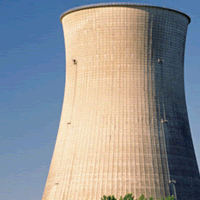 From the power reactors that provide electricity to millions of Americans, to the medical isotopes used to treat cancer patients, the Nuclear Reactors, Materials, and Waste Sector covers most aspects of America’s civilian nuclear infrastructure. The Nuclear Sector-Specific Agency within the Department of Homeland Security is responsible for coordinating the security and resilience of the Nuclear Sector.
From the power reactors that provide electricity to millions of Americans, to the medical isotopes used to treat cancer patients, the Nuclear Reactors, Materials, and Waste Sector covers most aspects of America’s civilian nuclear infrastructure. The Nuclear Sector-Specific Agency within the Department of Homeland Security is responsible for coordinating the security and resilience of the Nuclear Sector.
Transportation Systems Structure
 The Transportation Systems Sector consists of seven key subsectors, or modes:
The Transportation Systems Sector consists of seven key subsectors, or modes:
- Aviation includes aircraft, air traffic control systems, and about 19,700 airports, heliports, and landing strips. Approximately 500 provide commercial aviation services at civil and joint-use military airports, heliports, and sea plane bases. In addition, the aviation mode includes commercial and recreational aircraft (manned and unmanned) and a wide-variety of support services, such as aircraft repair stations, fueling facilities, navigation aids, and flight schools.
- Highway and Motor Carrier encompasses more than 4 million miles of roadway, more than 600,000 bridges, and more than 350 tunnels. Vehicles include trucks, including those carrying hazardous materials; other commercial vehicles, including commercial motorcoaches and school buses; vehicle and driver licensing systems; traffic management systems; and cyber systems used for operational management.
- Maritime Transportation System consists of about 95,000 miles of coastline, 361 ports, more than 25,000 miles of waterways, and intermodal landside connections that allow the various modes of transportation to move people and goods to, from, and on the water.
- Mass Transit and Passenger Rail includes terminals, operational systems, and supporting infrastructure for passenger services by transit buses, trolleybuses, monorail, heavy rail—also known as subways or metros—light rail, passenger rail, and vanpool/rideshare. Public transportation and passenger rail operations provided an estimated 10.8 billion passenger trips in 2014.
- Pipeline Systems consist of more than 2.5 million miles of pipelines spanning the country and carrying nearly all of the nation’s natural gas and about 65 percent of hazardous liquids, as well as various chemicals. Above-ground assets, such as compressor stations and pumping stations, are also included.
- Freight Rail consists of seven major carriers, hundreds of smaller railroads, over 138,000 miles of active railroad, over 1.33 million freight cars, and approximately 20,000 locomotives. An estimated 12,000 trains operate daily. The Department of Defense has designated 30,000 miles of track and structure as critical to mobilization and resupply of U.S. forces.
- Postal and Shipping moves about 720 million letters and packages each day and includes large integrated carriers, regional and local courier services, mail services, mail management firms, and chartered and delivery services.
Water and Wastewater Systems Sector
 There are approximately 153,000 public drinking water systems and more than 16,000 publicly owned wastewater treatment systems in the United States. More than 80 percent of the U.S. population receives their potable water from these drinking water systems, and about 75 percent of the U.S. population has its sanitary sewerage treated by these wastewater systems.
There are approximately 153,000 public drinking water systems and more than 16,000 publicly owned wastewater treatment systems in the United States. More than 80 percent of the U.S. population receives their potable water from these drinking water systems, and about 75 percent of the U.S. population has its sanitary sewerage treated by these wastewater systems.
The Water and Wastewater Systems Sector is vulnerable to a variety of attacks, including contamination with deadly agents; physical attacks, such as the release of toxic gaseous chemicals; and cyberattacks. The result of any variety of attack could be large numbers of illnesses or casualties and/or a denial of service that would also impact public health and economic vitality. The sector is also vulnerable to natural disasters. Critical services, such as firefighting and healthcare (hospitals), and other dependent and interdependent sectors, such as Energy, Food and Agriculture, and Transportation Systems, would suffer negative impacts from a denial of service in the Water and Wastewater Systems Sector.










